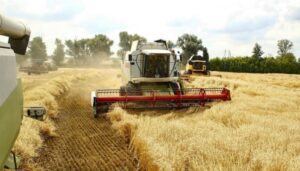
Passenger traffic on the western section of the border on April 11 amounted to over 62 thousand, which is 8 thousand, or 11.4% less than the day before.
“Compared to the previous day, there is a decrease in the intensity of passenger traffic,” the State Border Service said on Tuesday.
The agency clarified that more than 35,000 left Ukraine against 39,000 a day earlier, and almost two-thirds of those who left came to Poland, which is in line with average values.
According to the State Border Service, the flow of people entering Ukraine on April 12 also decreased to over 27,000 from the maximum 30,000 recorded on the weekend since the beginning of the war. Including Ukrainian citizens, 24,000 entered on Monday against 27,000 on Sunday.
According to the data of the Polish border service on Twitter, on April 11, 24 thousand people entered the country from Ukraine, which is 16% less, and in the first 7 hours of Tuesday, the flow decreased by another 14%, to 5.1 thousand. In the direction of Ukraine on Monday 16.6 thousand people left against 19.4 thousand people the day before.
The State Border Service of Ukraine also reported that over the past day the number of registered vehicles with humanitarian cargo fell to 390 from 460 the day before.
According to UNHCR data, as of 13:00 on April 10, a total of 4.55 million people have left Ukraine since the beginning of the war, of which Poland received 2.62 million, Romania and Moldova – 771.32 thousand, Hungary – 424.37 thousand. , Russia – 404.42 thousand, Slovakia – 317.78 thousand, Belarus – 20.74 thousand.

Representatives of the European Union met with representatives of the Cabinet of Ministers of Ukraine in Kyiv to discuss the application for EU accession, Head of the EU Delegation to Ukraine Matti Maasikas said.
“The best possible start to my first official working day back in Kyiv. Meeting with Deputy Prime Minister for European and Euro-Atlantic Integration Olha Stefanishyna, representatives of the European Commission for Neighborhood and Enlargement, the EU Delegation to Ukraine and the Cabinet of Ministers of Ukraine on the questionnaire, the basis for the EU Commission forthcoming opinion on Ukraine’s EU membership application. Working 24/7 as tasked by Ursula von der Leyen,” he said on Twitter.
As reported, President of the European Commission Ursula von der Leyen handed over to President of Ukraine Volodymyr Zelensky a questionnaire for joining the EU on April 9.

The EU has developed a plan for reverse gas supplies to Ukraine and Moldova in case these countries experience interruptions in supplies from Russia, Bloomberg reported on Monday, citing Energy Commissioner Kadri Simson.
“She told reporters in Vienna that the EU in the current situation cannot consider Russia a trustworthy partner, and therefore interruptions are not ruled out,” the agency writes.
In addition, Simson noted that Brussels is assessing what difficulties the economies and citizens of the EU countries will face if this integration association imposes an embargo on oil supplies from Russia.

Ukraine in the current season can grow and harvest 63 million tons of grain and oilseeds, approximately from 20 million hectares.
The corresponding estimates of the possible harvest were published on the website of the Ukrainian Grain Association (UGA) on Monday.
“Ukraine, in the conditions of aggression from Russia, will still be with grain. This year, despite the fact that 5 million hectares cannot be sown or it will be impossible to harvest on them, Ukraine can receive about 63 million tons of grain and oilseeds from an area of about 20 million hectares. At the same time, the domestic market of Ukraine consumes about 30 million tons of grain and oilseeds annually,” the association’s report says.
In addition, subject to the reorientation of exports from seaports blocked by the aggressor country of the Russian Federation to land transportation, the country will be able to export up to 35 million tons of agricultural crops in the 2022/2023 marketing year (MY, July-June).
UGA recalled that Ukraine in the current MY 2021/2022 due to the Russian blockade of seaports will not be able to export about 20 million tons of grain, which will be forced to store in elevators as transitional balances for the next MY.
According to the association, today the capacity of alternative logistics routes bypassing seaports is 600,000 tons of crops per month, but this figure can be increased by increasing the capacity of railway and logistics crossings at the borders with EU countries. Thus, thanks to the optimization of logistics, the export of grain and oilseeds in MY 2022/2023 can be expected at the level of 35 million tons.
“The current developments of the government and the public in the field of logistics and exports allow expanding the throughput to 2 million tons of crops per month. To reach the level of exports of 35 million tons of grains and oilseeds per year, it is necessary to further expand the throughput at the EU borders to 3 million tons per month,” the UGA said.
According to her, the wheat harvest in Ukraine in the current MY will decrease by 1.8 times – from 33 million tons in 2021/2022 MY to 18.2 million tons, but this figure is almost three times more than Ukraine consumes wheat per year. Taking into account the transitional stocks of wheat of the last harvest of almost 10 million tons, exports of wheat in 2022/2023 MY, with such harvest indicators and taking into account large transitional stocks, can amount to about 10 million tons.
In addition, the country can harvest up to 6.2 million tons of barley this season (in 2021 – 10.1 million tons), so its export in 2022/2023 MY can be expected at the level of 2 million tons.
The corn harvest can be expected at the level of 23.1 million tons (in 2021 – 37.6 million tons), while its exports may reach about 20 million tons.
The rapeseed harvest can be expected at the level of 1.5 million tons (2.9 million tons), while its export in 2022/2023 MY is expected at the level of 1.3 million tons.
The soybean harvest can be expected at the level of 1.8 million tons (in 2021 – 3.5 million tons), and exports in 2022/2023 MY are projected at the level of 0.6 million tons.
“Thus, Ukraine will be guaranteed to have sufficient grain reserves, while the countries of the world will not receive a significant amount of grain from Ukraine due to Russia’s war against Ukraine and rising prices, which, according to UN estimates, could cause famine in many countries of the world. In particular, Ukraine traditionally exports about 30-35% of grain to the countries of North Africa and the Middle East, 30-35% to the countries of South and Southeast Asia, and about 35-40% to European countries,” the UGA concluded in its forecast.
As reported, before the Russian military invasion, Ukraine monthly exported up to 5 million tons of agricultural products through the ports of Odessa and Nikolaev, however, due to the blockade of these ports by the aggressor country of the Russian Federation, the country can transport no more than 0.5 million tons of grain monthly, which leads to a monthly shortage $1.5 billion in export earnings.
Ukraine in 2021, according to the State Statistics Service, harvested a record harvest of 85.7 million tons of grain and leguminous crops, which is 32% higher than in 2020, including 32.07 million tons of wheat (+28.9%), 41.87 million tons of corn (+38.2%) and 9.42 million tons of barley (+23.3%).
In addition, 593.9 thousand tons of rye were harvested in Ukraine (+30% by 2020), 471 thousand tons of oats (-7.3%), 204.2 thousand tons of millet (-20.2%) , 173.9 thousand tons of sorghum (+63.2%), 106.0 thousand tons of buckwheat (+8.5%), 48.6 thousand tons of rice (-20%), 32.3 thousand tons triticale (-7.8%), as well as 681 thousand tons of other leguminous crops.
Among other crops in the country last year, 16.38 million tons of sunflower were harvested (+25% compared to 2020), 10.8 million tons of sugar beet (+18.1%), 3.5 million tons of soybeans (+24. 4%), 2.92 million tons of rapeseed and 42 thousand tons of oilseed flax (an increase of 3.7 times).

New Zealand will send a C-130 Hercules transport plane with 50 servicemen to Europe to participate in the distribution of military aid to Ukraine, Prime Minister Jacinda Ardern announced.
Over the next two months, our C-130 will join a chain of military aircraft from partner countries that will travel across Europe delivering much-needed equipment and supplies to key distribution centers, Ardern was quoted as saying by local media.
New Zealand will also allocate an additional NZ$ 13 million to help Ukraine, including 7.5 million for the purchase of weapons and ammunition through the UK. At the moment, the total contribution of New Zealand is $30 million.

The Cabinet of Ministers has legally confirmed the decision to terminate trade relations with the Russian Federation, Deputy Prime Minister and Minister of Economy of Ukraine Yulia Svyrydenko has said.
“A very important decision was made. This is a legal confirmation of the actual termination of trade relations with the Russian Federation, which happened on February 24,” Svyrydenko said on the national telethon on Saturday evening following the government meeting.
According to her, such a decision would annually block Russia’s foreign exchange earnings by at least $6 billion.